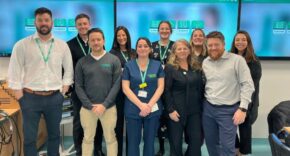
Trusts respond to rapidly increasing need to share more doctors.
With second lockdown well underway and the NHS returned to the top level of emergency preparedness, the worry is this wave will hit a perfect storm.
The storm includes a Covid surge in cases and usual winter pressures coupled with the fact that the NHS’s defences are currently lower than at the start of the first wave, with many staff in isolation or sick or simply burnt-out by pandemic with reports suggesting that on Friday 31 October 2020, more than 75,000 NHS staff were off sick. And, as NHS Providers CEO Chris Hopson said this week, “all on top of 80,000 vacancies”.
Yet, amid the pressure, swathes of new ways of working are emerging, some hospitals and Trusts are collaborating on staffing support at a scale not seen before, driven by the pandemic and powered by technology.
From Essex to Gloucestershire, right across southern England, (eight) Trusts which used to silo their staffing pools individually and only have access to a relatively small list of locum doctors, have now merged their pools with neighbouring Trusts and created collaborative banks of healthcare workers.
This allows Trusts to increase the flexibility of their workforce, have access to thousands, not just dozens, of doctors every day, for the first time.
As Suzanne Rankin, CEO, Ashford & St Peter’s Hospitals NHS Foundation Trust says: “If you’re not already using the collaborative bank, you should.”
Nicholas Andreou, co-founder of Locum’s Nest, which runs the biggest collaborative staff bank in the UK said. “Part of the issue today, across the entire country, is clearly staffing – in some areas demand already exceeds supply. More doctors will be trained, and more nurses will be recruited in the future, but the Service needs solutions today.
“Doctors with Covid, nurses isolating after coming into contact and others who are simply exhausted, all of which heaps more pressure on the remainder and pushes them closer to exhaustion. Part of the answer must be making best use of existing resources.
“Many Trusts now, however, are offsetting these issues by sharing workforce for the benefit of the whole region. This open approach is better for each individual hospital, Trust, staff and, most importantly, means more shifts are filled meaning more patients receive care.
“For example, in Hampshire in October our doctors filled 372 shifts that might otherwise have had no doctor and 77 of these shifts were covered by doctors who work at nearby Trusts that also belong to the Digital Collaborative Bank. That amounts to around 4,000 hours of patient care, or half a calendar year’s worth on manhours packed in to October alone.
“It seems very clear to me that these pools of extra, flexible, staff have grown substantially this year as a direct result of Covid-19. The very clear direction of travel is increased numbers of pools which get ever bigger and then merge until there is just one single NHS staff bank, accessed by all Trusts.
“The impact will, in effect, be to have a group of doctors and allied health professionals who work where and when they are needed across the country.”
All of this is further supported by Suzanne Rankin, CEO, Ashford & St Peter’s Hospitals NHS Foundation Trust, one of the founding Trusts of the Digital Collaborative Bank, “There is a big opportunity here for us, working within the Collaborative, which far outweighs the risks. With its scale, the bigger it gets the better its efficiency and fill rate become, and the transparent way of working has helped us improve harmonisation of rates, switch agency shifts to bank and vastly improve shift fill rate and reduce costs. Doctors are empowered to take control of their patterns of working as well as gain experience across a range of clinical settings.
“This collaboration has enabled my colleagues to meet the needs of patients and the team not only in our hospitals but also in hospitals and GP practices across the region and I’m proud of being part of something that benefits the wider NHS.”











